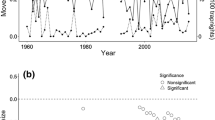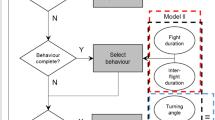Abstract
A pertinent question in animal population ecology is the relationship between population abundance, density, and mobility. Two extreme ways to reach sufficient abundance for long-term persistence are to inhabit restricted locations at high densities, or large areas in low densities. The former case predicts low individual mobility, whereas the later predicts high one. This assumption is rarely tested using across-species comparisons, due to scarcity of data on both mobility and population sizes for multiple species. We used data on dispersal and local population densities of six butterfly species gained by mark-recapture, and data on their (relative) regional abundance obtained by walking transects in a landscape surrounding the mark-recapture sites. We correlated both local density and regional abundance against slopes of the inverse power function, appropriate for describing the shape of dispersal kernel. Local densities correlated negatively with the dispersal kernel slopes both when sexes were treated as independent data points and if treated together. For regional abundance, the correlation was also negative but only marginally significant. Our results corroborate the notion that a trade-off exists between living in dense populations and having poor dispersal, and vice versa. We link this observation to resource use by individual species, and distribution of such resources as host plants in the study landscape.


Similar content being viewed by others
References
Akaike H (1981) Likelihood of a model and information criteria. J Econom 16:3–14
Auckland JN, Debinski DM, Clark WR (2004) Survival, movement, and resource use of the butterfly Parnassius clodius. Ecol Entomol 29:139–149
Baguette M (2003) Long distance dispersal and landscape occupancy in a metapopulation of the cranberry fritillary butterfly. Ecography 26:153–160
Baguette M, Schtickzelle N (2006) Negative relationship between dispersal distance and demography in butterfly metapopulations. Ecology 87:648–654
Baguette M, Convie I, Neve G (1996) Male density affects female spatial behaviour in the butterfly Proclossiana eunomia. Acta Oecol 17:225–232
Baguette M, Petit S, Queva F (2000) Population spatial structure and migration of three butterfly species within the same habitat network: consequences for conservation. J Appl Ecol 37:100–108
Boggs CL (1997) Reproductive allocation from reserves and income in butterfly species with differing adult diets. Ecology 78:181–191
Boggs CL, Ross CL (1993) The effect of adult food limitation on life history traits in Speyeria mormonia (Lepidoptera: Nymphalidae). Ecology 74:433–441
Brunzel S (2002) Experimental density-related emigration in the cranberry fritillary Boloria aquilonaris. J Insect Behav 15:739–750
Cizek O, Konvicka M (2005) What is a patch in a dynamic metapopulation? Mobility of an endangered woodland butterfly, Euphydryas maturna. Ecography 28:791–800
Cowley MJR, Thomas CD, Roy DB, Wilson RJ, Leon-Cortes JL, Gutierrez D, Bulman CR, Quinn RM, Moss D, Gaston KJ (2001a) Density-distribution relationships in British butterflies. I. The effect of mobility and spatial scale. J Anim Ecol 70:410–425
Cowley MJR, Thomas CD, Wilson RJ, Leon-Cortes JL, Gutierrez D, Bulman CR (2001b) Density-distribution relationships in British butterflies. II. An assessment of mechanisms. J Anim Ecol 70:426–441
Cozzi G, Muller CB, Krauss J (2008) How do local habitat management and landscape structure at different spatial scales affect fritillary butterfly distribution on fragmented wetlands? Landsc Ecol 23:269–283
Dennis RLH, Shreeve TG, Van Dyck H (2003) Towards a functional resource-based concept for habitat: a butterfly biology viewpoint. Oikos 102:417–426
Dover JW, Rescia A, Fungarino S, Fairburn J, Carey P, Lunt P, Dennis RLH, Dover CJ (2010) Can hay harvesting detrimentally affect adult butterfly abundance? J Insect Conserv 14:413–418
Ehrlich PR, Hanski I (2004) On the wings of checkerspots: a model system for population biology. Oxford University Press, Oxford
Enfjäll K, Leimar O (2005) Density-dependent dispersal in the Glanville fritillary, Melitaea cinxia. Oikos 108:46–472
Frankham R (1995) Conservation genetics. Annu Rev Genet 29:305–327
Fric Z, Konvicka M (2007) Dispersal kernels of butterflies: power-law functions are invariant to marking frequency. Basic Appl Ecol 8:377–386
Fric Z, Klimova M, Hula V, Konvicka M (2005) Caterpillars of Argynnis aglaja (Linnaeus, 1758) (Lepidoptera, Nymphalidae) feeding on Bistorta major. Atalanta 36:119–121 + ii
Fric Z, Hula V, Klimova M, Zimmermann K, Konvicka M (2010) Dispersal of four fritillary butterflies within identical landscape. Ecol Res 25:543–552
Gilbert LE, Singer M (1973) Dispersal and gene flow in a butterfly species. Am Nat 107:58–72
Hanski I, Thomas CD (1994) Metapopulation dynamics and conservation—a spatially explicit model applied to butterflies. Biol Conserv 68:167–180
Hill JK, Thomas CD, Lewis OT (1996) Effects of habitat patch size and isolation on dispersal by Hesperia comma butterflies: implications for metapopulation structure. J Anim Ecol 65:725–735
Hoole JC, Joyce DA, Pullin AS (1999) Estimates of gene flow between populations of the swallowtail butterfly, Papilio machaon in Broadland, UK and implications for conservation. Biol Conserv 89:293–299
Hovestadt T, Nieminen M (2009) Costs and benefits of dispersal in butterflies. In: Settele J, Shreeve T, Konvicka M, Van Dyck H (eds) Ecology of butterflies in Europe. Cambridge University Press, Cambridge, pp 97–106
Hula V, Konvicka M, Pavlicko A, Fric Z (2004) Marsh Fritillary (Euphydryas aurinia) in the Czech Republic: monitoring, metapopulation structure, and conservation of an endangered butterfly. Entomol Fenn 4:231–241
Johannesen J, Schwing U, Seufert W, Seitz A, Veith M (1997) Analysis of gene flow and habitat patch network for Chazara briseis (Lepidoptera: Satyridae) in an agricultural landscape. Biochem Syst Ecol 25:419–427
Kadlec T, Vrba P, Kepka P, Schmitt T, Konvicka M (2010) Tracking the decline of the once-common butterfly: delayed oviposition, demography and population genetics in the hermit Chazara briseis. Anim Conserv 13:172–183
Kindvall O, Vessby K, Berggren A, Hartman G (1998) Individual mobility prevents an Allee effect in sparse populations of the bush cricket Metrioptera roeseli: an experimental study. Oikos 81:449–457
Konvicka M, Hula V, Fric Z (2003) Habitat of pre-hibernating larvae of the endangered butterfly Euphydryas aurinia (Lepidoptera: Nymphalidae): what can be learned from vegetation composition and architecture? Eur J Entomol 100:313–322
Kotiaho JS, Kaitala V, Komonen A, Paivinen J (2005) Predicting the risk of extinction from shared ecological characteristics. Proc Natl Acad Sci USA 102:1963–1967
Krauss J, Schmitt T, Seitz A, Steffan-Dewenter I, Tscharntke T (2004) Effects of habitat fragmentation on the genetic structure of the monophagous butterfly Polyommatus coridon along its northern range margin. Mol Ecol 13:311–320
Kuras T, Benes J, Fric Z, Konvicka M (2003) Dispersal patterns of endemic alpine butterflies with contrasting population structures: Erebia epiphron and E. sudetica. Popul Ecol 45:115–123
Kuussaari M, Nieminen M, Hanski I (1996) An experimental study of migration in the Glanville fritillary butterfly Melitaea cinxia. J Anim Ecol 65:791–801
Labine PA (1964) Population biology of the butterfly Euphydryas editha. I. Barriers to multiple inseminations. Evolution 18:335–336
Lebreton JD, Burnham KP, Clobert J, Anderson DR (1992) Modeling survival and testing biological hypotheses using marked animals—a unified approach with case studies. Ecol Monogr 62:67–118
Matter SF, Roland J, Moilanen A, Hanski I (2004) Migration and survival of Parnassius smintheus: detecting effects of habitat for individual butterflies. Ecol Appl 14:1526–1534
Menendez R, Gutierrez D, Thomas CD (2002) Migration and Allee effects in the six-spot burnet moth Zygaena filipendulae. Ecol Entomol 27:317–325
Murphy DD, Menninger MS, Ehrlich PR, Wilcox BA (1986) Local population dynamics of adult butterflies and the conservation status of 2 closely related species. Biol Conserv 37:201–223
Neve G, Barascud B, Descimon H, Baguette M (2008) Gene flow rise with habitat fragmentation in the bog fritillary butterfly (Lepidoptera: Nymphalidae). BMC Evol Biol 8:84
O’Grady JJ, Reed DH, Brook BW, Frankham R (2004) What are the best correlates of predicted extinction risk? Biol Conserv 118:513–520
Ockinger E, Smith HG (2007) Asymmetric dispersal and survival indicate population sources for grassland butterflies in agricultural landscapes. Ecography 30:288–298
Paivinen J, Grapputo A, Kaitala V, Komonen A, Kotiaho JS, Saarinen K, Wahlberg N (2005) Negative density-distribution relationship in butterflies. BMC Biol 3:5
Paradis E, Baillie SR, Sutherland WJ, Gregory RD (1998) Patterns of natal and breeding dispersal in birds. J Anim Ecol 67:518–536
Sander AC, Purtauf T, Wolters V, Dauber J (2006) Landscape genetics of the widespread ground-beetle Carabus auratus in an agricultural region. Basic Appl Ecol 7:555–564
Schmitt T, Cizek O, Konvicka M (2005) Genetics of a butterfly relocation: large, small and introduced populations of the mountain endemic Erebia epiphron silesiana. Biol Conserv 123:11–18
Schneider C, Dover J, Fry GLA (2003) Movement of two grassland butterflies in the same habitat network: the role of adult resources and size of the study area. Ecol Entomol 28:219–227
Singer MC, Stefanescu C, Pen I (2002) When random sampling does not work: standard design falsely indicates maladaptive host preference in a butterfly. Ecol Lett 5:1–6
Smee M, Smyth W, Tunmore M, Ffrench-Constant R, Hodgson D (2010) Butterflies on the brink: habitat requirements for declining populations of the marsh fritillary (Euphydryas aurinia) in SW England. J Insect Conserv 15:153–163
Stacey PB, Taper M (1992) Environmental variation and the persistence of small populations. Ecol Appl 2:18–29
Stevens VM, Turlure C, Baguette M (2010) A meta-analysis of dispersal in butterflies. Biol Rev 85:625–642
Talsma JR, Torri K, van Nouhuys S (2008) Host plant use by the Heath fritillary butterfly, Melitaea athalia: plant habitat, species and chemistry. Arthropod Plant Interact 2:63–75
Thomas JA (1983) The ecology and conservation of Lysandra bellargus (Lepidoptera: Lycaenidae) in Britain. J Appl Ecol 20:59–83
Traill LW, Bradshaw CJA, Brook BW (2007) Minimum viable population size: a meta-analysis of 30 years of published estimates. Biol Conserv 139:159–166
Travis JMJ, Murrell DJ, Dytham C (1999) The evolution of density-dependent dispersal. Proc R Soc Lond B Biol 266:1837–1842
Vandewoestijne S, Schtickzelle N, Baguette M (2010) Positive correlation between genetic diversity and fitness in a large, well-connected metapopulation. BMC Biol 6:46
Wahlberg N, Klemetti T, Selonen V, Hanski I (2002) Metapopulation structure and movements in five species of checkerspot butterflies. Oecologia 130:33–43
Wang RJ, Wang YF, Chen JJ, Lei GC, Xu RM (2004) Contrasting movement patterns in two species of chequerspot butterflies, Euphydryas aurinia and Melitaea phoebe, in the same patch network. Ecol Entomol 29:367–374
White GC, Burnham KP (1999) Program MARK: survival estimation from populations of marked animals. Bird Study 46(Suppl):120–139
Zimmermann K, Fric Z, Filipova L, Konvicka M (2005) Adult demography, dispersal and behaviour of Brenthis ino (Lepidoptera: Nymphalidae): how to be a successful wetland butterfly. Eur J Entomol 102:699–706
Zimmermann K, Konvicka M, Fric Z, Cihakova V (2009) Demography of a common butterfly on humid grasslands: Argynnis aglaja (Lepidoptera: Nymphalidae) studied by mark-recapture. Pol J Ecol 57:715–727
Zimmermann K, Blazkova P, Cizek O, Fric Z, Hula V, Kepka P, Novotny D, Slamova I, Konvicka M (2011) Adult demography in the Marsh fritillary butterfly, Euphydryas aurinia (Rottenburg, 1775) in the Czech Republic: patterns across sites and seasons. Eur J Entomol 108:243–254
Acknowledgments
Over 20 persons participated in the marking campaigns. As space does not allow listing all of them, we name just the most active ones: M. Bartos, L. Filipova, M. Maradova, J. Patera, M. Lövy, D. Novotny. Funding was provided by Czech Conservation Authority (contractual payments for E. aurinia monitoring), the Karlovy Vary region (D723/2007), Czech Ministry of Education (6007665801, 6215648905, LC06073), and Czech Science Foundation (P505/10/2167).
Author information
Authors and Affiliations
Corresponding author
Rights and permissions
About this article
Cite this article
Konvicka, M., Zimmermann, K., Klimova, M. et al. Inverse link between density and dispersal distance in butterflies: field evidence from six co-occurring species. Popul Ecol 54, 91–101 (2012). https://doi.org/10.1007/s10144-011-0277-2
Received:
Accepted:
Published:
Issue Date:
DOI: https://doi.org/10.1007/s10144-011-0277-2




